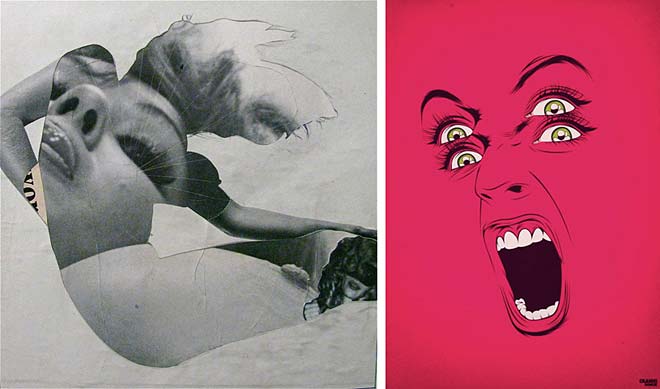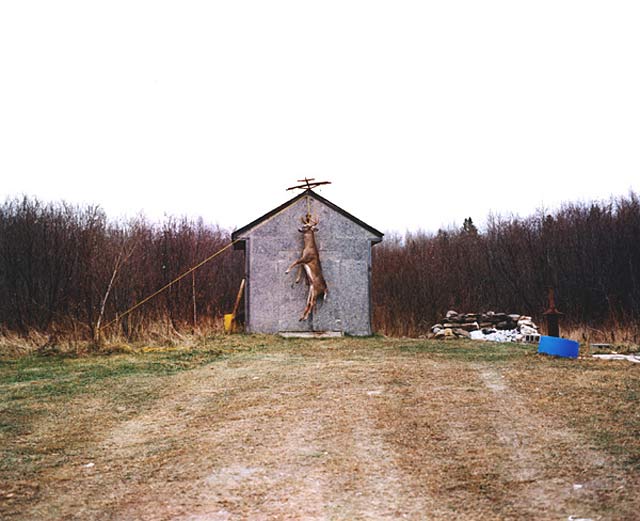horror

A simple mathematical model of the brain explains the pattern of murders by a serial killer, say researchers
On 20 November 1990, Andrei Chikatilo was arrested in Rostov, a Russian state bordering the Ukraine. After nine days in custody, Chikatilo confessed to the murder of 36 girls, boys and women over a 12 year period. He later confessed to a further 20 murders, making him one of the most prolific serial killers in modern history.
Today, Mikhail Simkin and Vwani Roychowdhury at the University of California, Los Angeles, release a mathematical analysis of Chikatilo’s pattern of behaviour. They say the behaviour is well characterised by a power law and that this is exactly what would be expected if Chikatilo’s behaviour is caused by a certain pattern of neuronal firing in the brain.
Their thinking is based on the fundamental behaviour of neurons. When a neuron fires, it cannot fire again until it has recharged, a time known as the refractory period.
Each neuron is connected to thousands of others. Some of these will also be ready to fire and so can be triggered by the first neuron. These in turn will be connected to more neurons and so on. So it’s easy to see how a chain reaction of firings can sweep through the brain if conditions are ripe.
But this by itself cannot explain a serial killer’s behaviour. “We cannot expect that the killer commits murder right at the moment when neural excitation reaches a certain threshold. He needs time to plan and prepare his crime,” say Simkin and Roychowdhury.
Instead, they suggest that a serial killer only commits murder after the threshold has been exceeded for a certain period of time.
They also assume that the murder has a sedative effect on the killer, causing the neuronal activity to drop below the threshold.
{ The Physics arXiv Blog | Continue reading }
photo { Lady detectives learning their trade. Mr. Kersey is showing them how to apprehend a suspect. April 1927. | Fox Photos/Getty Images }
horror, incidents, neurosciences | January 16th, 2012 3:31 pm

Ed was devoted to his mother, who was quite demented and thoroughly disgusted with sex. She thought it was the world’s greatest evil so she preached to her two sons that they were to keep themselves pure.
When her husband died, she had even more influence, and then Ed’s brother died, leaving him alone with this delusional woman. Mildly retarded and mentally unstable, he was completely dependent on her. When she suffered a stroke that paralyzed her, he nursed her even as she verbally abused him. Sometimes he crawled into bed with her to cuddle.
Then when Ed was 39, his mother died. He could hardly bear it. He kept to the farm and spent his time doing odd jobs and reading magazines about headhunters, human anatomy, and the Nazis. He also contemplated sex-change surgery so he could become his mother—to literally crawl into her skin.
{ TruTV | Continue reading }
Searching Ed’s house, authorities found:
▪ Four noses
▪ Whole human bones and fragments
▪ Nine masks of human skin
▪ Bowls made from human skulls
▪ Ten female heads with the tops sawn off
▪ Human skin covering several chair seats
▪ Mary Hogan’s head in a paper bag
▪ Bernice Worden’s head in a burlap sack
▪ Nine vulvae in a shoe box
▪ A belt made from female human nipples
▪ Skulls on his bedposts
▪ A pair of lips on a draw string for a window-shade
▪ A lampshade made from the skin from a human face
These artifacts were photographed at the crime lab and then were properly destroyed.
{ Wikipedia | Continue reading }
horror, weirdos | January 6th, 2012 9:59 am

Cannibal Holocaust is a 1980 Italian horror film directed by Ruggero Deodato.
The film tells the story of a missing documentary film crew who had gone to the Amazon to film indigenous tribes. A rescue mission, led by the New York University anthropologist Harold Monroe, recovers their lost cans of film, which an American television station wishes to broadcast. Upon viewing the reels, Monroe is appalled by the team’s actions, and after learning their fate, he objects to the station’s intent to air the documentary. Much of Cannibal Holocaust is the portrayal of the recovered film’s content, which functions similarly to a flashback and grows increasingly disturbing as the film progresses.
Cannibal Holocaust achieved notoriety because its graphic violence aroused a great deal of controversy. After its premiere in Italy, it was seized by a local magistrate, and Deodato was arrested on obscenity charges. He was charged with making a snuff film due to rumors that claimed some actors were killed on camera. Although Deodato was later cleared, the film was banned in Italy, the UK, Australia, and several other countries due to its graphic depiction of violence, sexual assault, and the actual slaughter of seven animals.
After seeing the film, director Sergio Leone wrote a letter to Deodato, which stated, [translated] “Dear Ruggero, what a movie! The second part is a masterpiece of cinematographic realism, but everything seems so real that I think you will get in trouble with all the world.” […]
The courts believed that the actors who portrayed the missing film crew and the native actress featured in the impalement scene were killed for the camera. Compounding matters was the fact that the supposedly deceased actors had signed contracts with the production which ensured that they would not appear in any type of media, motion pictures, or commercials for one year following the film’s release. This was done in order to promote the idea that Cannibal Holocaust was truly the recovered footage of missing documentarians.
{ Wikipedia | Continue reading }
Francesca Ciardi was one of four actors whom the Italian police believed had been murdered in the making of the 1980 horror film Cannibal Holocaust. So realistic was the film that shortly after it was released its director Ruggero Deodato was arrested for murder. The actors had signed contracts to stay out of the media for a year in order to fuel rumours that the film was a snuff movie. The court was only convinced that they were alive when the contracts were cancelled and the actors appeared on a television show as proof.
{ Wikipedia | Continue reading }
flashback, horror, marketing, showbiz | December 2nd, 2011 11:50 am

In 2009, a nine year-old Brazilian girl became pregnant with twins after being raped by her stepfather. With advice from doctors, her mother opted for her to have an abortion. After pleading with Brazil, which outlaws abortions except when the mother’s life is in danger or when she has been raped, her daughter was granted one. Then things got really ugly. When the Archbishop of the city of Recife heard the news he invoked Canon law and excommunicated the mother and daughter and the members of the medical team who performed the abortion; the stepfather, meanwhile, remained a loyal and accepted member of the church. (…)
The question is: why do humans remain so steadfast to their beliefs, sometimes even in the face of overwhelming opposing evidence?
The answer rests in a few psychological tendencies that when mixed together form a potent recipe for ignorance. The first is confirmation bias – the propensity for people to look for what confirms their beliefs and ignore what contradicts their beliefs while not being concerned for the truth. (…)
Then there’s cognitive dissonance, which describes a “state of tension that occurs whenever a person holds two cognitions that are psychologically inconsistent.” (…)
Finally, there’s motivated reasoning, which describes our tendency to accept what we want to believe with much more ease and much less analysis than what we don’t want to believe.
{ Why We Reason | Continue reading }
horror, psychology | September 9th, 2011 1:43 pm

{ Suicide methods differ between men and women. Men nearly twice as likely as women to use a method that disfigures the face or head when taking their own lives. | EurekAlert }
genders, horror, psychology | August 30th, 2011 11:26 am

Häxan (English title: The Witches or Witchcraft Through The Ages) is a 1922 Swedish/Danish silent film written and directed by Benjamin Christensen.
Based partly on Christensen’s study of the Malleus Maleficarum, a 15th century German guide for inquisitors, Häxan is a study of how superstition and the misunderstanding of diseases and mental illness could lead to the hysteria of the witch-hunts.
The film was made as a documentary but contains dramatized sequences that are comparable to horror films. With Christensen’s meticulous recreation of medieval scenes and the lengthy production period, the film was the most expensive Scandinavian silent film ever made, costing nearly two million Swedish krona. Although it won acclaim in Denmark and Sweden, the film was banned in the United States and heavily censored in other countries for what were considered at that time graphic depictions of torture, nudity, and sexual perversion.
{ Wikipedia | Continue reading }
flashback, horror, showbiz, weirdos | July 20th, 2011 4:47 pm

Inferno (Italian for “Hell”) is the first part of Dante’s 14th-century epic poem Divine Comedy. It is followed by Purgatorio and Paradiso. It is an allegory telling of the journey of Dante through what is largely the medieval concept of Hell.
Hell is depicted as nine circles of suffering located within the Earth.
First Circle: Limbo
Second Circle: Lust
Third Circle: Gluttony
Fourth Circle: Greed
Fifth Circle: Anger
Sixth Circle: Heresy
Seventh Circle: Violence
Eighth Circle: Fraud
Ninth Circle: Treachery
{ Wikipedia | Continue reading }
books, horror | July 18th, 2011 2:00 pm

In the four billion years since life on Earth began, there have been five times when there was a sudden mass extinction of life-forms. The last time was 65 million years ago, when the dinosaurs were killed, probably by a meteor. But now the world’s scientists agree that the sixth mass extinction is at hand. Humans have accelerated the rate of species extinction by a factor of at least 100, and the great Harvard biologist EO Wilson warns that it could reach a factor of 10,000 within the next 20 years. We are doing this largely by stripping species of their habitats. We are destroying the planet’s biodiversity, and so we are making the natural chains that keep us alive much more vulnerable to collapse. This time, we are the meteor.
At the same time, we are dramatically warming the atmosphere. I know it has become terribly passé to listen to virtually all the world’s scientists, but I remember the collapsing glaciers I saw in the Arctic, the drying-out I saw in Darfur, and the rising salt water I saw in Bangladesh. 2010 was the joint-hottest year ever recorded, according to Nasa. The best scientific prediction is that we are now on course for a 3ft rise in global sea levels this century. That means goodbye London, Cairo, Bangkok, Venice and Shanghai. Doubt it if you want, but the US National Academy of Sciences – the most distinguished scientific body in the world – just found that 97 per cent of scientific experts agree with the evidence.
{ The Independent | Continue reading }
painting { Jean-Léon Gérôme }
climate, horror, pipeline | May 30th, 2011 6:18 pm
asia, elements, horror, science | March 11th, 2011 5:15 pm

Mankind may have unleashed the sixth known mass extinction in Earth’s history, according to a paper released by Nature.
Over the past 540 million years, five mega-wipeouts of species have occurred through naturally-induced events.
But the new threat is man-made, inflicted by habitation loss, over-hunting, over-fishing, the spread of germs and viruses and introduced species and by climate change caused by fossil-fuel greenhouse gases, says the study.
Evidence from fossils suggests that in the “Big Five” extinctions, at least 75 percent of all animal species were destroyed.
Palaeobiologists at the University of California at Berkeley looked at the state of biodiversity today, using the world’s mammal species as a barometer.
Until mankind’s big expansion some 500 years ago, mammal extinctions were very rare: on average, just two species died out every million years.
But in the last five centuries, at least 80 out of 5,570 mammal species have bitten the dust, providing a clear warning of the peril to biodiversity.
{ The Independent | Continue reading }
images { 1. Erik Foss | 2. Alejandro Garcia }
horror, science | March 10th, 2011 7:10 pm

Begotten is a 1991 experimental/horror film, directed and written by E. Elias Merhige. The film deals with the story of Genesis. But as Merhige revealed during Q&A sessions, its primary inspiration was a near death experience he had when he was 19, after a car crash. The film features no dialogue, but uses harsh and uncompromising images of human pain and suffering to tell its tale. It also has no music, instead, the movie is accompanied by the sounds of crickets, and occasionally other sound effects such as grunting and thrashing.
Plot
The film was shot on black and white reversal film, and then every frame was rephotographed for the look that is seen. The only colors are black and white, with no half-tones. The look is described in the trailer as “a Rorschach test for the eye”. Merhige said that for each minute of original film, it took up to 10 hours to rephotograph it for the look desired.
The film opens with a robed, profusely bleeding “God” disemboweling himself, with the act ultimately ending in his death. A woman, Mother Earth, emerges from his remains, arouses the body, and impregnates herself with his semen.
{ Wikipedia | Continue reading } |

Antropophagus, released in the UK as Anthropophagous: The Beast and in the US as Anthropophagus: The Grim Reaper, is a 1980 Italian language horror film, directed by Joe D’Amato.
Plot
A group of tourists arrive on a small Greek island, only to find it almost completely deserted. It seems that the only person still alive there is a blind girl who does not know what has happened to the rest of the island’s town, but is terrified of a man who she describes as smelling of blood. (…)
They find a diary inside an abandoned mansion, which tells of a man who was shipwrecked with his wife and child. In order to survive, the man was forced to eat his dead family. This act drove him insane and he went on to slaughter the rest of the island’s inhabitants. (…)
Almost the entire group is killed until only a few remain, but one of the survivors manages to overpower him and stab him with a pick axe to the stomach, and before he dies, in one final act of insanity, he attempts to devour himself, by chewing violently on his own intestines.
{ Wikipedia | Continue reading } |
{ Thanks Caitie for the inspiring discussion }
halves-pairs, horror, showbiz, weirdos | February 5th, 2011 9:00 pm

A shortage of a drug used in executions in the United States has sent U.S. states scrambling to find supplies, or alternative drugs. Among the 35 states in which capital punishment is legal, some–including Arizona and California–had been sourcing a key execution drug, sodium thiopental, through a company in London–until UK government officials put a stop to its export. The only U.S. company making the drug, which sought to move its manufacturing base to Italy, has now given up producing sodium thiopental because it cannot assure Italian officials that it won’t be used for executions.
{ Scientific American | Continue reading }
photo { Tierney Gearon }
drugs, economics, horror, uh oh | January 31st, 2011 1:32 pm

The slasher horror film has been the subject of frequent criticism based on the assumption that female characters in these films are more likely to be the victims of serious, graphic violence that is juxtaposed with explicit sexual imagery. The purpose of this study was to address limitations inherent in previous analyses of slasher films and examine whether gender differences exist in the nature of violent presentations. A content analysis of several indicators of violent and sexual content was conducted using a random sample of 50 slasher films that were released in North America between 1960 and 2007. Findings suggested that there are several significant gender differences in the nature of violent presentations found in slasher films. In general, female characters were more likely to be victims of less serious and graphic forms of violence, but were also significantly more likely to be victimized in scenes involving a concomitant presentation of sex and violence.
{ Sex and Violence in the Slasher Horror Film: A Content Analysis of Gender Differences in the Depiction of Violence by Andrew Welsh, Ph.D., Department of Criminology and Contemporary Studies | PDF }
horror, sex-oriented, showbiz | December 16th, 2010 7:40 pm

Murder followed by suicide is not an uncommon event, and several research reports have appeared on the topic. For example, Palermo, et al. (1997) found that typical murder-suicide in the Midwest of America was a white man, murdering a spouse, with a gun in the home. In England, Milroy (1993) reported that 5% to 10% of murderers committed suicide. Most were men killing spouses, with men killing children second in frequency. Shooting was the most common method. Similar patterns have been observed in Canada and Japan.
Mass murder has become quite common in recent years, from workers at post offices “going postal” to school children killing their peers in school. (…)
There are many categories of mass homicide, including familicides, terrorists, and those who simply “run amok.” (…)
Holmes and Holmes (1992) classified mass killers into five types: Disciples (killers following a charismatic leader), family annihilators (those killing their families), pseudocommandos (those acting like soldiers), disgruntled employees, and set-and-run killers (setting a death trap and leaving, such as poisoning food containers or over-the-counter medications).
It has been difficult to study several of these categories of mass murderers because no one has developed a comprehensive list of murderers falling into the groups. The only category studied hitherto has been the pseudocommandos (also known as rampage murders). (…)
The 98 incidents with a single perpetrator took place from 1949 to 1999, with 90% taking place in the period 1980-1999. (…) 56 of the killers were captured, 7 were killed by the police and one by a civilian, and 34 completed suicide at the time of the act (that is, within a few hours of the first killing and before capture). (…)
In contrast to mass murder, serial killers are defined as those who kill three or more victims over a period of at least thirty days (Lester, 1995). No study had appeared prior to 2008 on the extent to which serial killers complete suicide, but the informal impression gained from studying the cases (e.g., Lester, 1995) is that suicide is less common among them. However, occasional serial killers do complete suicide. (…)
Some serial killers commit suicide after being sent to prison. (…)
Some serial killers have made failed suicide attempts (e.g., Cary Stayner) before they embarked upon their serial killing. They appear to have turned their suicidal urges into murderous rampages.
{ Suicide in Mass Murderers and Serial Killers | Suicidology Online | Continue reading | PDF }
guns, horror, science | November 30th, 2010 7:17 pm

Genie was a pseudonym for a girl who was found in extremely poor conditions. Not only were her surroundings incredibly unstimulating, they were also very dirty and horrid. The author of Philo-Psych (2009) states that “After it was revealed by a doctor that Genie’s language was slightly delayed, her father considered her retarded. Presumably to shelter her from a life of shame and embarrassment, he kept her in a room, strapped to a baby toilet, and only occasionally fed her baby food for 13 years.”
Although she was 13, she had the appearance of a 7 year old, and had extremely underdeveloped linguistic skills. Rather than talking, she made noises or yelps. The case of Genie presented psychologists with various questions over social, developmental and linguistic aspects of human development.
In the following video from the BBC’s Genie: A Deprived Child, we see what the story of Genie is all about, with those who worked with her.
{ John Wayland | Continue reading | video }
illustration { Ana Bagayan }
horror, kids, psychology | November 23rd, 2010 4:07 pm

Rising ocean levels brought about by climate change have created a flood of unprecedented legal questions for small island nations and their neighbors.
Among them: If a country sinks beneath the sea, is it still a country? Does it keep its seat at the United Nations? Who controls its offshore mineral rights? Its shipping lanes? Its fish?
And if entire populations are forced to relocate — as could be the case with citizens of the Maldives, Tuvalu, Kiribati and other small island states facing extinction — what citizenship, if any, can those displaced people claim?
{ Scientific American | Continue reading }
related { Ten Amazing Uninhabited Islands }
future, horror, incidents, law, water | November 20th, 2010 2:44 pm

A German researcher has studied medieval criminal law and found that our image of the sadistic treatment of criminals in the Dark Ages is only partly true. Torture and gruesome executions were designed in part to ensure the salvation of the convicted person’s soul. (…)
New access to existing sources, such as law books and pamphlets, has enabled Schild to soften the prevailing view of the past. Many descriptions from centuries past were “distorted and exaggerated to make the past seem particularly dark and the present more radiant,” says Schild.
The Renaissance poet Petrarch, for example, carried this sort of fiction to extremes. He dreamed up the “brazen bull,” a hollow object made of metal that was placed over a fire while the condemned criminals inside were cooked alive. But the executioners of the Middle Ages were not driven by such sadistic impulses.
{ Der Spiegel | Continue reading }
photo { Jocelyn Lee }
flashback, horror | November 16th, 2010 6:40 pm

A report issued this month found that nearly 1,000 tigers had been killed in the last decade as part of illegal trade. The numbers are based on tiger seizures from 11 of the 13 countries that still have wild tiger populations. That is 100 tigers a year falling victim to poachers. When estimates put the wild population at 3,500 individuals or less, loss of 100 a year to poachers is devastatingly high.
{ Promega Connections | Continue reading }
Tigers survive in 40% less area than they occupied a decade ago. (…)
Three tiger subspecies - the Bali, Javan, and Caspian - have become extinct in the past 70 years. The six remaining subspecies - Amur, Bengal, Indochinese, Malayan, South China, and Sumatran - live only in Asia, and all are threatened by poaching and habitat loss.
{ WWF | Continue reading }
animals, horror | November 9th, 2010 5:55 pm

In her new documentary, Picture Me, Columbia University student Sara Ziff chronicles her 4-year rise and exit through the fashion modeling industry, zooming her personal camcorder onto supposedly systemic abuses—sexual, economic, and emotional—suffered by fashion models. Among the many complaints launched in the film is an aesthetic that prizes uniformly young, white, and extremely thin bodies measuring 34-24-34” (bust-waist-hips) and at least 5’10” in height. It’s an aesthetic that many of the models themselves have a tough time embodying, pushing some into drastic diets of juice-soaked cotton balls, cocaine use, and bulimia—in my own interviews with models I discovered similar, but not very common, practices of Adderall and laxative abuse.
It’s also an aesthetic that has weathered a tough media storm of criticism, set off in 2005 with the anorexia-related deaths of several Latin American models, and which culminated in the 2006 ban of models in Madrid Fashion Week with excessively low Body Mass Indexes (BMI). And yet, as a cursory glance at the Spring 2011 catwalks will reveal, thin is still in.
In fact, bodies remain as gaunt, young, and pale as they did five years ago, and it’s entirely likely that in another five years models will look more or less the same as they do now.
What’s the appeal of an aesthetic so skinny it’s widely described by the lay public as revolting?
{ Ashley Mears/Savage Minds | Continue reading }
photo { Hedi Slimane }
fashion, health, horror | October 31st, 2010 8:34 am

{ The townspeople demanded that Mary be killed. Debates on how to kill Mary ensued. It was determined that no gun existed big enough to take her down. Electrocution and canons were other proposed methods. Finally, it was decided that Mary would be hung from a rail yard crane in the nearby town of Erwin, Tennessee. | Keep my words | Continue reading }
related { Squirrels refuse medical care }
bonus:

{ Sam Hood Baby elephant, Taronga Zoo, 1930s }
animals, flashback, horror, incidents | October 12th, 2010 6:01 pm
























